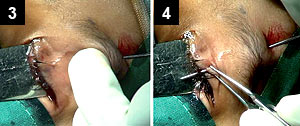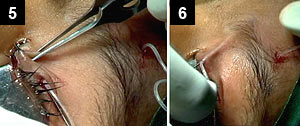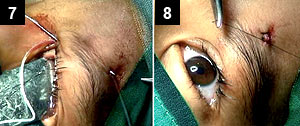Surgeons explain new guided sling technique to treat ptosis
The procedure uses a single stab incision to guide the silicone suspension set in the muscle plane.

 Amar Agarwal |
There are various techniques for treating and managing ptosis. We will describe a new surgical technique for acquired and congenital ptosis with poor levator function in which the Seiff silicone suspension set is used in a frontalis sling procedure.
The entire length of the silicone set is guided in the muscle plane through a single stab incision. The advantages of the procedure include less surgical time, absence of multiple incisions, minimal postoperative scars or edema, and early recovery. Six eyes of five patients underwent this technique for congenital ptosis with poor levator function, and the postoperative outcomes were comparable with conventional frontalis sling surgery. Thus, it provides enhanced cosmesis while retaining the usual advantages of standard sling procedures.
Introduction
Frontalis muscle suspension procedure is the gold standard for the treatment of congenital ptosis with poor levator function. It creates a linkage between the frontalis muscle and the tarsus of the upper eyelid, which allows for a better eyelid position in primary gaze.
There have been various modifications of the sling procedures in the past. Different sling materials, from autologous fascia lata to several suture materials, have been tried. Our technique differs from the conventional procedures in the use of a single forehead stab incision in making the pentagon or triangle and guiding the silicone sling in the muscle plane with only one external incision while suspending the lid from the frontalis muscle.
Surgical technique
The upper eyelid is infiltrated with lidocaine 2% with 1:100,000 epinephrine. In children, surgery is performed under general anesthesia.
Under aseptic precaution, the area is cleaned and draped. The pentagon shape is marked over the skin with a marker (Figure 1). The amount of upper lid elevation needed is again checked on the table. A single suprabrow stab incision of about 2.5 mm to 3 mm is made on the superior mark of the pentagon about 5 mm from the eyebrow (Figure 2). A sterile Seiff silicone frontalis suspension set dipped in antibiotic solution is then taken. This has a long silicone tube with stainless steel hollow rods on both ends with moderately sharp ends. Each rod measures about 6.3 cm. The overall diameter of the rod is 20 gauge.
 | |
| (1) Jacob-Agarwal technique of guided sling surgery. A single pentagon is marked on the skin. (2) The Seiff suspension set is passed through the suprabrow incision. Images: Agarwal A |
 | |
| (3) On reaching the corner of the pentagon, instead of bringing the needle out through an incision, its direction is changed and it is passed downward and guided using a combination of visualization and palpation along the lower limb of the pentagon toward the lid margin mark. (4) The needle is then pierced out through the lid margin mark. |
 | |
| (5) It is then reinserted through the same needle prick exit point and passed through the superficial tarsal tissues to emerge through a needle prick exit on the other lid margin mark. This thus avoids any incisions on the lid margin and no sutures need be applied. (6) An upward pass is made to the upper corner of the pentagon. |
 | |
| (7) On reaching here, the direction of the needle is changed while maintaining the surgical plane, and it is guided out of the central suprabrow incision without exteriorizing it anywhere along its path. (8) The single 2.5-mm suprabrow incision is closed with a suture or with fibrin glue. |
One end of the tube is advanced through the stab incision in the muscle plane (Figure 3) and guided along the skin markings. When the corner of the pentagon is reached, it is then turned downward along the marks made on the overlying skin. Care is taken so that the surgeon maintains the muscle plane throughout the procedure. If crumbling of tissue is observed while advancing the rod, it indicates that the plane of the tissue in which the rod is positioned is not uniform. The surgeon’s left hand index finger (Figures 3 and 4) can be used to palpate while the rod is advanced underneath.
When the lid margin incision mark is reached, without actually making an incision, the needle end is pierced out through the skin and exteriorized. It is then passed in again through the needle exit point, through the superficial tarsal tissues to pierce out through the other marked lid margin incision site (Figures 5 and 6). The upward pass is then made, again entering through the needle exit point and on reaching the eyebrow mark, is turned in direction and guided so that it exits through the same superior stab incision (Figures 7 and 8). The two ends of the silicone rods are passed through the silicone sleeve and knotted. The lid margin height and contour are adjusted according to the amount of correction required. A silk suture is tied between the knots to prevent late slippage. The sleeve with the knots is then buried below the subperiosteal pocket and may be anchored with a silk stay suture. The single suprabrow stab incision is closed with silk suture or with fibrin glue.
Discussion
The advantage of the Jacob-Agarwal technique is that with minimal skin incisions and less surgical time, the clinical outcome of a conventional frontalis sling procedure is obtained. Postoperative lid edema, pain and suture-related complications due to multiple sutures can be avoided.
The technique can be performed in all eyes with ptosis and poor levator function that necessitate frontalis sling. The stab incision used is only about 2.5 mm. It is advantageous over the conventional procedure that involves five incisions, which create more bleeding and edema in the postoperative period.
There have been reports in the past on minimum incision and incision-free sling procedures. Our technique differs from other procedures by using the commonly used silicone sling familiar to ptosis surgeons instead of other nonabsorbable sutures. Lid closure is therefore better than other materials. Although silicone material for frontalis sling suspension has been tried successfully in the past, our method of guided sling procedure with silicone sling has not been reported. It also differs in that the ends of the sling material are united in the central forehead incision, rather than in the eyelid incision as previously described by other authors, which makes it better by giving a more physiological upward direction of traction, giving a better lid height and contour.
We believe our technique will provide better aesthetic and functional results in patients with poor levator function who require better cosmetic results.
For more information:
- Amar Agarwal, MS, FRCS, FRCOphth is director of Dr. Agarwal’s Group of Eye Hospitals. Prof. Agarwal is the author of several books published by SLACK, Incorporated, publisher of Ocular Surgery News, including Phaco Nightmares: Conquering Cataract Catastrophes, Bimanual Phaco: Mastering the Phakonit/MICS Technique, Dry Eye: A Practical Guide to Ocular Surface Disorders and Stem Cell Surgery, and Presbyopia: A Surgical Textbook. He can be reached at 19 Cathedral Road, Chennai 600 086, India; fax: 91-44-28115871; e-mail: dragarwal@vsnl.com; Web site: www.dragarwal.com.
